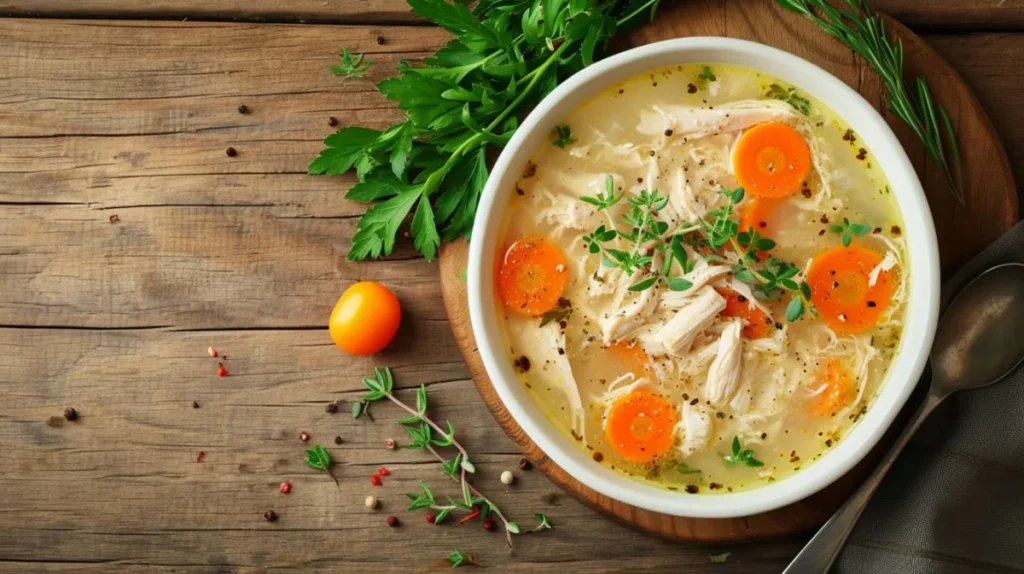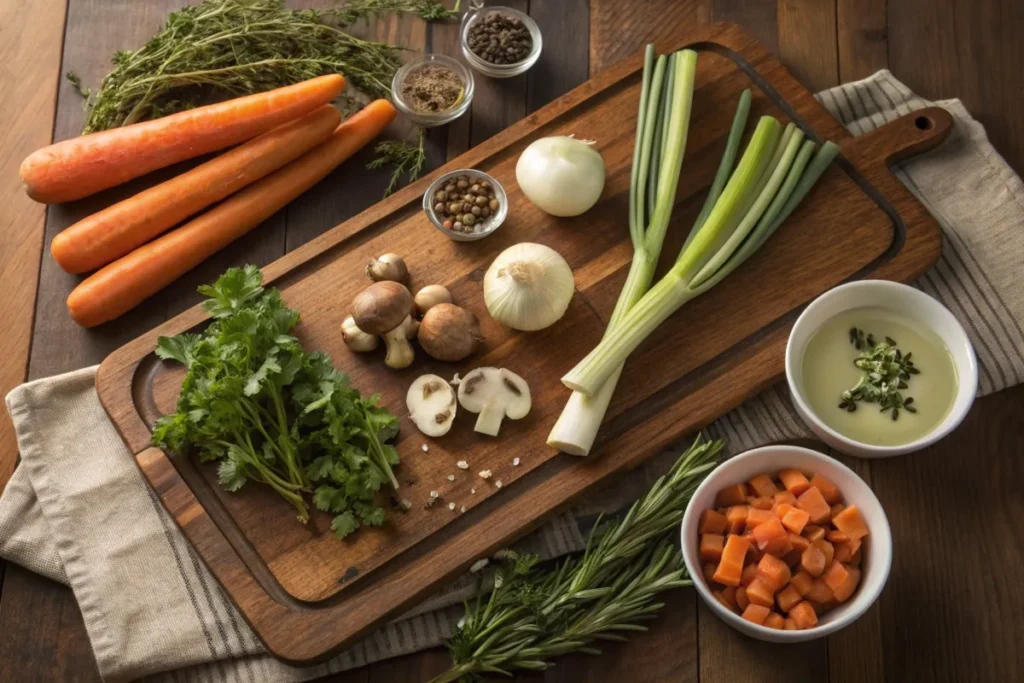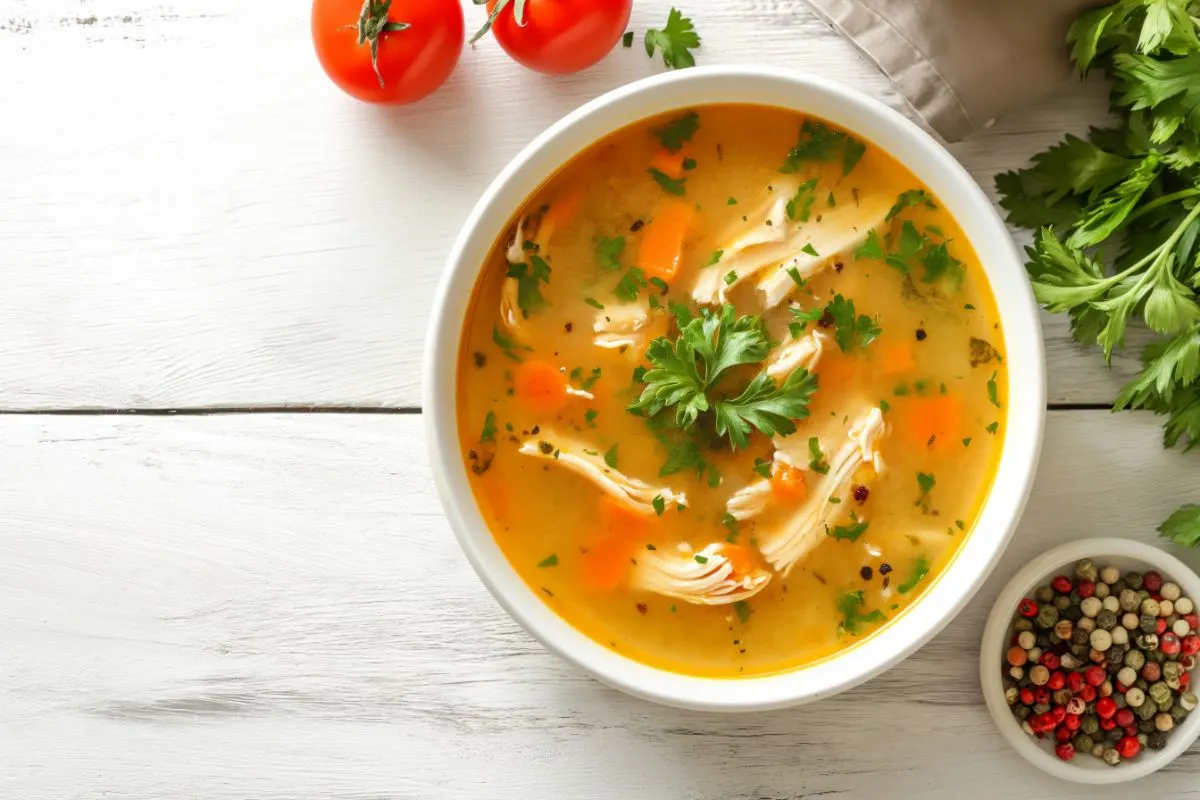Description: Transform bland broth into flavorful turkey soup with simple tips, rich stock, herbs, and umami for a tasty, comforting meal.
Introduction
When you sit down to a bowl of flavorful turkey soup, each spoonful should feel like a warm, comforting hug. Yet, many home cooks find themselves disappointed by watery, bland broths that fail to please the palate. However, transforming a flat-tasting turkey soup into a rich, savory, and downright irresistible meal is simpler than you might think. In fact, by understanding the fundamental reasons behind blandness, choosing the right ingredients, and applying the proper cooking techniques, you can master the art of creating tasty and flavorful turkey soup that your family and friends will love.
In this article, we will thoroughly explore practical ways to boost your soup’s depth at every stage. For instance, we’ll examine how to build a robust base, incorporate herbs and spices, introduce umami elements, and balance flavors with acidity, sweetness, and freshness. Moreover, you’ll discover how leftover turkey and thoughtful garnishes can help you create a more savory turkey soup that will have everyone asking for seconds. Finally, we’ll provide a detailed recipe, nutritional information, and clear answers to common questions so you can confidently elevate your next batch of turkey soup.
Table of Contents
Understanding Why Your Turkey Soup Isn’t Flavorful
Even before you start adding layers of complexity, it’s crucial to understand why your turkey soup might lack flavor. In many cases, a rich, flavorful turkey soup relies on properly extracted flavors and balanced seasoning. Often, blandness is the result of relying solely on turkey meat without enhancing the stock, skipping aromatics, or diluting the soup with too much water.
Common Reasons for Blandness:
- Insufficiently seasoned stock or broth
- Minimal use of vegetables, herbs, and spices
- Overly diluted liquids, resulting in weak flavor
- Lack of umami-building techniques
Therefore, by recognizing these pitfalls, you can approach your next pot of turkey soup with greater precision. Consequently, you’ll soon discover that taking a little extra time and care can yield far more satisfying results.
Building a Rich Base for Your Flavorful Turkey Soup
Start with Quality Turkey Stock for a Savory Turkey Soup
Your soup’s foundation matters, and thus, for a truly tasty turkey soup, begin with a high-quality turkey stock. In many cases, it’s best to make your own by simmering roasted turkey bones, aromatics, and herbs for hours. As a result, this extended cooking time extracts gelatin, minerals, and deep flavors that give your soup a rich body. If homemade stock isn’t an option, however, choose a low-sodium store-bought turkey or chicken broth to avoid overly salty flavors. In addition, consider diluting it with a small amount of vegetable broth for added complexity while maintaining a savory backbone.
Harness Aromatics for Enhanced Turkey Soup Flavor
Aromatics are key to enhancing turkey soup flavor, so start by using classic mirepoix—onion, carrots, and celery—because they bring natural sweetness and earthy notes. Moreover, sauté these vegetables until they release their fragrances. In addition, for even deeper complexity, add minced garlic, diced shallots, or thinly sliced leeks. Furthermore, consider incorporating dried mushrooms like shiitake or porcini for an extra layer of umami that makes your soup more enticing.
Layer Flavors Early for a More Flavorful Turkey Soup
Building a rich turkey soup base involves careful layering. After sautéing your aromatics, for example, stir in a spoonful of tomato paste or miso paste. Indeed, these flavor boosters add depth and complexity. Consequently, gently simmering these elements together helps create a strong foundation that permeates the entire soup.
Elevating Your Flavorful Turkey Soup with Herbs and Spices

Infuse Your Tasty Turkey Soup with Fresh and Dried Herbs
To truly make your flavorful turkey soup shine, consider how herbs can shape its character. For example, classic herbs like parsley, thyme, and bay leaves lend subtle complexity, while sage and rosemary contribute earthiness. If you crave global flavors, meanwhile, experiment with dried oregano or cilantro. Because dried herbs take longer to release their essence, add them early in the cooking process. Conversely, reserve fresh herbs until the end to preserve their bright flavors.
Add Spices for Enhanced Turkey Soup Flavor
Spices can transform your soup into a multi-dimensional masterpiece. For instance, a pinch of smoked paprika, cumin, or ginger can introduce warmth. Additionally, mild chili flakes or turmeric offer vibrant color and gentle heat. Above all, by starting with small amounts and tasting as you go, you can craft a tasty turkey soup that aligns perfectly with your personal flavor preferences.
Don’t Forget Salt and Pepper
No matter what else you add, do not underestimate salt’s importance. In fact, salt enhances natural flavors, making every other ingredient taste better. Moreover, using it in layers—adding a pinch at the beginning, another halfway through, and a final adjustment at the end—is crucial. Likewise, freshly ground black pepper adds a subtle aromatic bite. Therefore, by controlling these basic seasonings carefully, you ensure that the complex flavors you’ve built are never overshadowed.
Taste and Adjust Continuously
Always taste as you cook. This simple practice helps you identify imbalances early. If the broth is flat, for example, add a small pinch of salt. If it feels too salty, however, introduce a splash of acidity. Consequently, by regularly sampling your soup, you maintain control and ensure that it evolves into an exceptionally flavorful turkey soup by the time it’s ready to serve.
Enhancing Your Flavorful Turkey Soup with Umami and Depth
Embrace Umami-Rich Ingredients
Umami, known as the fifth taste, adds savory depth that enhances your tasty turkey soup. Therefore, consider dried mushrooms, miso paste, or a few drops of soy sauce to infuse a subtle, rich backbone. Even a small spoonful of tomato paste can increase umami levels. Thus, with these ingredients, your turkey soup shifts from ordinary to extraordinary.
Balance Bold Flavors in Your Savory Turkey Soup
Using umami boosters is about balance. If your soup becomes too intense, for instance, lighten it with a mild splash of vinegar or a squeeze of citrus juice. In addition, a sprinkle of fresh herbs can restore brightness. As a result, by balancing strong umami flavors with other taste elements, you create a harmonious, delicious turkey soup that delights your guests.
Brightening and Balancing Your Flavorful Turkey Soup
Add Acidity for Tasty Turkey Soup
A hint of acidity can make your turkey soup pop. Accordingly, a small addition of apple cider vinegar or lemon juice at the end of cooking cuts through richness and awakens the palate. Consequently, this step ensures every spoonful of your flavorful turkey soup is lively and well-rounded.
Introduce Sweetness and Freshness
Do not underestimate the power of sweetness and freshness. For example, caramelized onions, diced carrots, or kernels of sweet corn can soften any bitterness and round out the soup’s profile. Furthermore, finishing with fresh parsley, cilantro, or microgreens adds that final layer of vibrant flavor, ensuring each bite is memorable.
Using Texture to Improve Your Flavorful Turkey Soup
Add Crunchy Toppings
Texture influences how flavors register on your palate. Therefore, top your savory turkey soup with homemade croutons, toasted pumpkin seeds, or crispy fried onions. As a result, these contrasts keep each spoonful exciting, encouraging you to savor the layers of flavor you’ve carefully developed.
Adjust Thickness and Mouthfeel
If you prefer a creamier consistency, blend a portion of the soup until smooth and then stir it back in. Thus, this technique increases body and richness. You can also add a small dollop of unsweetened plant-based cream or mashed root vegetables for a thicker, more luxurious mouthfeel, thereby enhancing your tasty turkey soup experience.
Maximizing Leftover Turkey for a More Flavorful Turkey Soup
Season and Marinate Your Leftovers
If you’re using leftover turkey, don’t let it remain bland. Instead, lightly season it with dry herbs and a bit of oil before adding it to the soup. In doing so, you infuse the meat with more flavor, ensuring a delicious turkey soup that doesn’t rely solely on the broth.
Consider Texture and Cuts
Shredding leftover turkey creates more surface area, allowing it to soak up the flavorful broth. On the other hand, cubed turkey provides a firmer bite. In fact, you can experiment to find your preference. Moreover, roasted vegetables like carrots, parsnips, or squash can add sweetness and complexity to a rich turkey soup that feels special and comforting.
Quick Fixes and Last-Minute Adjustments for Your Flavorful Turkey Soup
Sometimes, even after following all these steps, you might taste your soup and sense it still needs something.
- Stir in a Flavorful Condiment: For instance, try a spoonful of pesto, mild chili paste, or a simple herb sauce.
- Add a Finishing Oil: A drizzle of sesame oil or a light herb oil can lift the flavors.
- Fine-Tune Seasoning: If it’s too salty, dilute with a bit of water or unsalted broth. If it’s flat, add a pinch of salt or a splash of vinegar. If it’s heavy, fresh herbs or a squeeze of citrus can restore balance.
By taking these quick actions before serving, you can ensure your flavorful turkey soup is just right.
Flavorful Turkey Soup Recipe

Below is a recipe that puts all these tips into action, resulting in a tasty turkey soup that is both easy to make and deeply satisfying.
Ingredients (Serves 6-8)
- 2 tablespoons neutral oil (e.g., vegetable oil)
- 1 medium onion, finely diced
- 2 medium carrots, diced
- 2 celery stalks, diced
- 2 cloves garlic, minced
- 1 cup mushrooms, sliced (fresh or dried, rehydrated)
- 8 cups low-sodium turkey stock
- 2 cups shredded cooked turkey
- 1 tablespoon tomato paste
- 1 tablespoon mild miso paste
- 2 bay leaves
- 1 teaspoon dried thyme
- 1 teaspoon dried parsley
- 1 teaspoon soy sauce (optional)
- 1 tablespoon apple cider vinegar (adjust to taste)
- Salt and freshly ground black pepper to taste
- Fresh parsley, chopped (for garnish)
- Optional toppings: homemade croutons, toasted pumpkin seeds
Instructions
- Sauté the Aromatics:
Heat oil in a large pot over medium heat. Next, add onion, carrots, and celery. Cook for 5-7 minutes, stirring often, until they begin to soften. Afterward, add garlic and mushrooms, and cook another 2 minutes. - Build a Rich Base:
Stir in the tomato paste and cook for 1 minute to caramelize. Then, add miso paste and a splash of turkey stock, scraping up any browned bits. Consequently, this step layers flavors that create a rich turkey soup base. - Season and Simmer:
Add the bay leaves, dried thyme, and dried parsley. Subsequently, pour in the remaining turkey stock and bring to a gentle simmer. Stir in shredded turkey and soy sauce (if using). Let the soup simmer for 20-30 minutes, tasting and adjusting seasoning as needed. Thus, each step contributes to a deeper, more complex flavor. - Balance the Flavors:
After simmering, taste your soup. If it’s flat, for example, add a pinch of salt. If it’s too salty, however, add water or more stock. If it needs brightness, stir in apple cider vinegar. As a result, your goal is a flavorful turkey soup that tastes balanced and satisfying. - Finish and Garnish:
Remove bay leaves. Subsequently, stir in fresh parsley and top each bowl with croutons or pumpkin seeds for added texture. Finally, serve hot and enjoy the results of your newfound turkey soup mastery.
Check out our Turkey Vegetable Soup Recipe
Nutritional Information (per 100g)
| Nutrient | Amount |
|---|---|
| Calories | ~50 kcal |
| Protein | ~5 g |
| Fat | ~2 g |
| Carbohydrates | ~4 g |
| Sugars | ~1 g |
| Fiber | ~1 g |
| Sodium | ~200 mg |
Note: Values are approximate and vary depending on exact ingredients.
FAQ
How to make bland soup taste better?
To make a bland soup taste better, start with a pinch of salt. Additionally, layer flavors by adding aromatics, herbs, and umami-rich ingredients like miso. Moreover, a splash of acidity, such as apple cider vinegar, can brighten the soup, while fresh herbs, crunchy toppings, or a drizzle of oil at the end can transform it into a flavorful turkey soup that excites your taste buds.
How do you spice up a bland turkey?
If your turkey tastes bland, season leftover turkey with dried herbs and a bit of oil before adding it to your soup. Furthermore, consider shredding it to increase surface area and allow it to soak up the broth’s flavors. By balancing the soup’s seasoning with salt, herbs, and umami boosters, you ensure your turkey doesn’t taste bland, resulting in a tasty turkey soup you’ll enjoy.
Why does my turkey stock taste bland?
If your turkey stock tastes bland, it may need more aromatics, roasting of bones, or a longer simmer. Therefore, consider adding vegetables like carrots, onions, and celery, as well as dried herbs. In addition, slow cooking for several hours extracts deeper flavors, resulting in a savory turkey soup base that sets the stage for a rich, flavorful meal.
Conclusion
In conclusion, crafting a flavorful turkey soup involves more than just tossing ingredients into a pot. Indeed, by starting with a rich stock, layering flavors with aromatics, herbs, and spices, and balancing umami, sweetness, and acidity, you can transform a bland broth into a comforting, full-bodied meal. Moreover, adjusting texture, using leftover turkey wisely, and making last-minute tweaks ensures that each bowl bursts with dimension and depth. Ultimately, with practice, experimentation, and the tips provided above, your turkey soup will consistently impress, leaving everyone eager for another spoonful.

